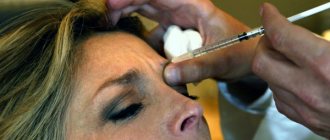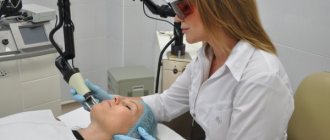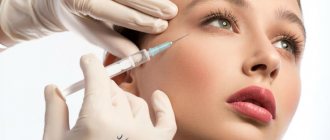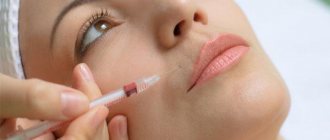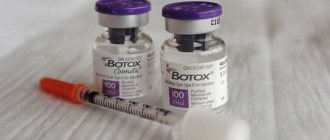Every woman wants to look her best in any situation. The pregnancy period in this case is considered ambiguous. A changing figure and hormonal changes often affect your appearance. Many women have a negative attitude towards changes, but concern for the health of the unborn baby prevents them from making adjustments. Diets, active physical activity, Botox - everything is prohibited. You have to choose what is more important: the beauty or the well-being of the child. Knowing how compatible Botox and pregnancy are is important for every expectant mother who is thinking about “beauty injections” that contain a poisonous toxin.
Botulinum toxin in the systemic circulation
To begin with, we should remember: in order to act on the myometrium or reach the placenta and negatively affect the fetus, the active substance must enter the systemic circulation.
Some reports indicated that, at high doses, BTA could diffuse from facial muscle tissue into the arm, as measured by single-fiber electromyography (EMG)2, 3. However, this effect appeared to be subclinical because no muscle weakness was detected in the affected individuals. If the dose of the drug did not exceed the recommended one, then during intramuscular injection BTA did not enter the systemic circulation4.
BTA is classified by the FDA as a Category C drug, which means that animal studies have shown adverse effects of the drug on the fetus and there have been no adequate studies in pregnant women, but the potential benefits associated with the use of this drug in pregnant women may justify its use despite existing risk.
In addition, studies have shown that molecules larger than 500 Daltons cannot cross the placenta5. The molecular weight of BTA exceeds 500 D, so BTA is unlikely to cross the placental barrier and is unlikely to be present in fetal blood.
To date, animal studies have found no evidence for transmission of toxins to the fetus. In rabbits, BTA was not detected in the placenta or in embryos when high (lethal) doses of the toxin were administered intravenously. Malformations and abortion were recorded only if rabbits received high-dose injections of BTA daily; conversely, pregnant mice treated with BTA did not show similar adverse outcomes6.
Effect of the toxin on the unborn child
Botox is essentially poison. Although the toxin is administered in small doses for cosmetic and medicinal purposes, this does not change its nature. A dangerous substance entering the body of a pregnant woman inevitably reaches the fetus. Whether it is possible to inject botulinum toxin while carrying a child is a controversial issue.
Studies of the negative side of the toxin's action were carried out exclusively on pregnant animals. Similar experiments are not carried out on humans. Taking into account the available data, it is possible to state the facts of the influence of Botox administered during pregnancy on:
- increased frequency of miscarriage;
- the birth of offspring with various defects (deviations from the norm, deformities).
Most often, non-standard development of the nervous and cardiovascular systems was observed. The general deterioration of the condition is known - endurance, life expectancy. The data suggest that the pattern of human fetal development under the influence of the toxin will have similar consequences.
Dystonia
Dystonia is a syndrome in which there is a constant spasmodic contraction of muscles, spasms are often unpredictable, change the normal position of the body, can be chronic and cause significant discomfort, pain and disability.
Article 1 examined the use of BTA in the treatment of idiopathic torsion dystonia, oromandibular dystonia, and spastic dystonia (Table 1).
As a rule, the disease begins before the onset of reproductive age and persists throughout life. Common in pregnant women. Currently, BTA injections are the preferred treatment option. Moreover, in 10% of patients the disease began suddenly in connection with pregnancy and childbirth. Ankola showed (a study of 350 patients) that pregnancy or pregnancy-related hormonal changes may be a risk factor for the disease7. Morgan found that in a survey of 396 doctors, nine pregnant women received a BTA injection during pregnancy. One patient had a spontaneous abortion, but the other eight patients gave birth to healthy children8. Blitzer11 summarized the data of 1300 patients with dystonias such as adductor and abductor dysphonia, and over 24 years, according to his data, the effectiveness of BTA was 91.2% and 70.3%.
Table 1.
Use of BTA for the treatment of dystonia during pregnancy (according to Wu Li, Min Tang1)
| Study | Number of BTA injections | Dosage/Duration of treatment | Result |
| Newman, 20049 | 3 | 15 weeks / 200 units. 21 weeks / 100 units. 32 weeks / 300 units | BTA improved the symptoms, which recurred approximately every 3–4 months. Over the next 9 years, the patient became pregnant three times and received BTA several times during each pregnancy. The injections gave good results in all three pregnancies, the patient gave birth to healthy children |
| Aranda et al.10 | 1 time in the second and third trimesters | The injection site and dose were identical to those used before pregnancy: 40 IU into the left sternomastoid muscle, 150 IU, and an additional 60 IU divided between the trapezius and right elevator scapula muscles. The total dose during pregnancy is 500 IU. | At the 40th week, the patient gave birth to a healthy baby (weight 3400 g). |
| Morgan8 | _ | _ | The patient experienced relief of symptoms and gave birth to a healthy baby20. |
Emergency Botox removal
There is no antidote for Botox. The drug is excreted exclusively naturally. This will take at least a month. Most methods that speed up the process are prohibited during pregnancy. A bathhouse, sauna, solarium, alcohol (popular methods of eliminating a toxic drug) will enhance the picture of negative consequences for a pregnant woman.
If pregnancy occurs unexpectedly immediately after Botox injections, it is recommended not to worry. If the procedure is done, it will not be possible to urgently change the situation.
No obvious negative effects of the toxic drug have been identified; cosmetic doses are minimal. If you want to quickly remove the toxin, it is better to seek the help of an experienced cosmetologist. The doctor will select the appropriate procedures. You can perform facial massage at home.
Strabismus
Deviation of the visual axes from the direction towards the object in question, in which the coordinated work of the eyes is disrupted and it becomes difficult for both eyes to fixate on the object of vision. BTA is considered an alternative to surgery.
Table 2.
| Study | Number of BTA injections | Dosage/Duration of treatment | Result |
| Morgan, 20048 | Two patients with strabismus received BTA during pregnancy | 1.25 to 300 IU | The therapeutic effect did not cause complications or fetal abnormalities |
| Lee Yim12 | 17 year old woman. The drug was administered before the patient knew she was pregnant | 2.5 IU | A healthy baby was born |
Alternative rejuvenation options
During pregnancy, it is difficult to find a worthy alternative to Botox. Most interventions are prohibited. Chemical peeling, biorevitalization, and deep massage will have to be abandoned. All that remains is careful care. Don't forget about cleansing, superficial peeling, and masks. An important aspect will be the selection of suitable cosmetics. You can learn about popular products from an experienced cosmetologist.
During pregnancy, it is especially important to organize healthy sleep, proper nutrition, and oxygen supply. This will support your health and have a positive effect on your appearance. At home, you can perform light massage and gymnastics. The procedures will maintain muscle tone and help reduce the number of wrinkles. A cosmetologist will always tell you how to maintain a decent appearance.
Botox during pregnancy is a procedure that requires serious consideration. Taking care of your health is the most important component of an “interesting situation.” There cannot be a choice between the well-being of pregnancy and increasing the attractiveness of appearance.
Esophageal achalasia
Functional obstruction of the esophagus. Characterized by loss of lower esophageal sphincter (LES) activity and esophageal motility; the main symptoms are dysphagia, chest pain and reflux.
Treatment options include diet, calcium channel blockers, and Heller myotomy. BTA can be injected locally into the stomach area. The procedure does not require deep anesthesia, and can relax the LES and relieve esophageal obstruction.
Table 3.
| Study | Number of BTA injections | Dosage/Duration of treatment | Result |
| Wataganara et al., 200913 | From 18th week | 80 U BTA | A healthy infant was born at 36 weeks' gestation and no swallowing problems were noted until 6 weeks postpartum. |
| Hooft 201514. | BTA at 14 weeks of pregnancy | 100U | Healthy baby |
| Holliday 201615 | BTA at 31 + 3 weeks of pregnancy | – | Eclampsia and childbirth at 37 + 4 weeks of pregnancy |
Question answer
Your doctor may be right in this situation.
Remember that Botox does NOT smooth out wrinkles. It only weakens the core muscles. This can cause wrinkles to smooth out or weaken the muscles that are important for blinking and closing your eyes safely. Additionally, too much Botox in an area can actually cause sagging and bagging. There are frequent discussions regarding this issue. Some experts believe that lying down can cause gravity to shift Botox to other areas that we don't want to hit. But this has not been proven or studied. But most doctors tell their patients this recommendation. After 4 hours there is no problem and you can lie on your back if you want.
Botox results typically last three to four months, but can last up to six months. Regular injections lead to a cumulative effect, which means that in the future you will need to visit the cosmetologist less often.
Chronic pelvic pain (CPP)
A common syndrome with various causes: the main and only symptom is pain, sometimes accompanied by defecation disorders. In addition to daily pain, patients often complain of dyspareunia and dysmenorrhea. In women, pain was significantly reduced after BTA injections.
Table 4.
| Study | Number of BTA injections | Dosage/Duration of treatment | Result |
| Abbott 200616 | 30 | 80 IU | Two women became pregnant 4 and 5 months after the injection; One woman (41 years old; complex medical history) had an elective caesarean section at 40 weeks and the baby had a ventricular septal defect that required surgical correction. However, it is unclear whether it was caused by BTA administration. |
| Abbott 200917 | Two cases during pregnancy | – | Both mothers had good results. |
How does the drug affect the health of a pregnant woman?
There is no exact data on how the expectant mother’s body will react to botulinum toxin. But doctors studied this drug by conducting experiments on animals.
It was found that botulinum toxin during pregnancy can provoke the following consequences:
- You may begin to feel dizzy and weak.
- If the body does not tolerate this remedy, then the woman may experience an allergic reaction. Allergies manifest themselves in the form of swelling, itching, and cough. As a result, the expectant mother's immunity will deteriorate.
- During pregnancy, special hormones are produced. Therefore, a woman is more vulnerable to various consequences that may appear after the injection. As a result, the drug may act unpredictably.
- After the injection, digestion may worsen.
Before such a procedure, many patients are very worried that it will negatively affect the health of the unborn baby. The pain that occurs during the injection will also not be beneficial.
Botox injections are not losing their popularity. In 2021 alone, almost 7.5 million procedures involving the administration of this drug were recorded. But during pregnancy it would be worth refraining from this manipulation.
Plastic surgeon Carlo Honrado
Migraine
Some migraine medications are considered unsafe for pregnant women18.
In 2000, Binder et al were the first to report that BTA was successfully used in patients with headache19. In a meta-analysis of 17 studies involving 3646 patients with chronic migraine, Brula et al found that BTA significantly reduced chronic migraine symptoms after 3 months of treatment compared with placebo; therefore, BTA was considered safe and well tolerated20.
Features of the procedure
Rejuvenation with Botox has the following features:
- First, the patient is recommended to undergo tests and undergo a consultation with a cosmetologist who will perform the procedure. The specialist must determine the degree of neglect of wrinkles, the necessary areas for needling, etc.
- Next, the day of the procedure is scheduled.
- During the session, the patient's skin is thoroughly treated with antiseptic solutions. Dots are placed at the injection site.
- The injection sites are cooled with ice and additionally numbed with special gels.
- Using special hardware devices, the cosmetologist determines the required areas for needle insertion and depth.
- After the procedure is completed, the patient's skin is re-treated with antimicrobial solutions.
Complication statistics
Wu Li, Min Tang1's findings on complications showed that rates of spontaneous abortion and fetal malformations in pregnant women treated with BTA were similar to those reported for the general population.
Tan reported 28 cases occurring before 2013 in patients who received BTA during pregnancy; including 25 normal births, 1 therapeutic abortion and 2 spontaneous abortions21.
In 2021, Brin et al. reported results in pregnant women who had received local injections of BTA within the previous 24 years. Of the 137 births (139 fetuses), 110 (79.1%) were live births, 29 (20.9%) were fetal loss (21 spontaneous abortions) and 8 abortions22. Among the live births, 106 (96.4%) were normal, only 4 patients had a poor outcome, two had minor fetal malformations and one congenital complication; the overall incidence of fetal malformations was 2.7%. They may not have been related to BTA treatment.
Work experience of craftsmen
Ask to show you the diploma of the master who will carry out this or that procedure, and what work experience he has. Don’t be shy about asking such questions, because we are talking about your beauty and health, as well as the safety of your unborn child.
To summarize, we can say that the practice of administering beauty injections and the use of drugs that include Botox during 9 months of gestation and lactation is prohibited. Beauty is, of course, good, but during this period a woman is responsible not only for herself, but also for the unborn baby.
Botulinum poisoning
There have been cases in the literature where high doses of BTA could cause symptoms of systemic botulinum poisoning.
However, a report by Brin et al. (2016) states that clinical botulism has no adverse effects associated with pregnancy or the fetus22. Badell studied maternal and fetal outcomes associated with botulinum poisoning in 16 women during pregnancy (11 cases in late pregnancy) and 1 woman after injection23. Although the pregnant women showed signs of poisoning, all babies were born healthy and only six patients experienced premature birth. Newborn blood tests did not show the presence of BTA in the systemic circulation; these findings also supported the hypothesis that BTA does not enter the fetal circulation24,25.
Indications and contraindications
Indications for Botox injections are:
- The appearance of the first signs of aging.
- The presence of vertical wrinkles between the eyebrows.
- Crow's feet in the eye area.
- Eyebrows that are too upturned or, conversely, drooping.
- Wrinkles on the bridge of the nose.
- Deep wrinkles on the forehead.
- Deep nasolabial folds.
Contraindications to this cosmetic procedure are:
- The patient's age is under twenty (twenty-five) years.
- HIV infection.
- Hepatitis.
- The period after recent surgery.
- The period after a stroke or heart attack.
- The patient's age is over sixty-five years.
Pregnancy and lactation period.
- Blood clotting disorder.
- Taking antibiotics and other drugs that can interfere with blood clotting.
- Individual patient intolerance to Botox.
- Weakened immunity.
- The period of exacerbation of chronic diseases.
- Disturbances in the central nervous system (depression, neurosis, stress).
- Acute infectious or respiratory diseases.
Advantages and disadvantages
Botox injections have the following advantages:
- The ability to quickly get rid of wrinkles.
- The ability to rejuvenate your face without surgery.
- You can get rid of sweating with these injections.
- Minor neurological disorders in the skin can be eliminated.
The disadvantages of the procedure are:
- There are many contraindications and restrictions.
- High cost of the procedure.
- The effect only lasts about six months. After this, you need to conduct a second course of rejuvenation.
- High risk of developing negative complications.
- You can't get rid of deep wrinkles.
Is it worth administering this drug while breastfeeding?
Doctors do not recommend administering Botox while breastfeeding.
This is explained by the fact that the substance of this drug can be excreted along with breast milk, which the child will then drink. Thus, the baby will still receive his “portion” of the harmful substance.
Moreover, for the same reason, during lactation, a woman is strictly prohibited from taking any oral medications and alcoholic beverages.
Find out what a scrub should be like for oily skin. Are you interested in a mask for dry skin? Click read.
